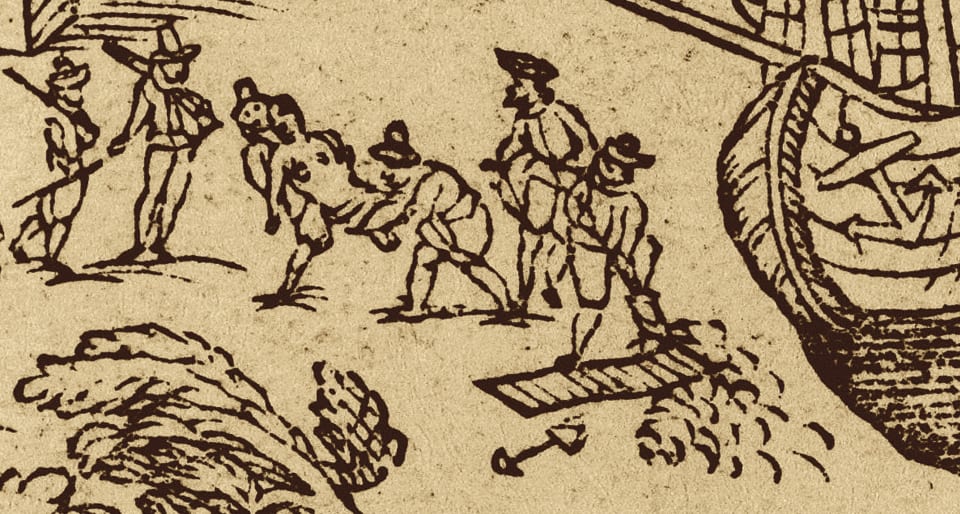Jacques Cartier thought he and his men had found the Northwest Passage to China, but before they could claim their place in history, they would have to wait out a harsh Canadian winter. Cartier’s ships spent November 1535 through April 1536 stuck near what is today Quebec City; they could not get past the rapids in the St. Lawrence River and soon found themselves stuck in the ice.
A 1541 map of the area tells the story succinctly, if a bit incorrectly. Near the island where the Frenchmen wintered, the mapmaker wrote: “Here many French died of hunger.”
Some of the French sailors did starve, but there was a far more deadly problem in their makeshift settlement. A mysterious disease attacked every single member of the French expedition. Sailors saw their limbs swell, and their gums began to rot. They lost their teeth. Some became feverish and suffered from convulsions. One account of the suffering recorded that the disease
spread itselfe amongst us after the strangest sort that ever was eyther heard of or seene, insomuch as some did lose all their strength, and could not stand on their feete, then did their legges swel, their sinnowes shrinke as blacke as any cole. Others also had all their skins spotted with spots of blood of a purple colour: then did it ascend up to their ankels, knees, thighes, shoulders, armes and necke: their mouth became stincking, their gummes so rotten, that all the flesh did fall off, even to the rootes of teeth, which did also almost fall out.
Cartier, worried that the local Iroquois people would attack his party if they knew how badly the French were suffering, tried to hide the condition of his men. But, eventually, things got so bad that there was no concealing the suffering. The Iroquois did not attack as Cartier had feared. Instead, they brought medicine, a tea brewed from evergreen twigs. The drink led to the miraculous recovery of many of the French sailors, whose death had seemed certain just days before.
Cartier, of course, had not discovered the Northwest Passage. But he and his men had discovered the horrors of scurvy and been shown a potential cure. But Europeans didn’t learn much from the incident; the Iroquois cure for the disease did not spread around the world.
Cartier didn’t even seem terribly grateful for having his life saved; he thanked the Iroquois by kidnapping their chief, Donnacona, and bringing him to France.
What Cartier didn’t know was that he and his men had not contracted a communicable disease; they were suffering from a simple Vitamin C deficiency. And terrible things happen to the human body when it doesn’t get enough of the nutrient.
People have suffered from scurvy for pretty much all of human history; evidence of the disease showed up in ancient Egypt, China, and Greece. But it really took its toll during the age of European exploration, as ships left the sight of land for weeks or months at a time, and crews were asked to subsist on salted meat and hardtack.
The effects of Vitamin C deficiency are depressingly predictable. A U.S. Navy surgeon cataloged them in the 19th century: victims’ skin bruises easily, their teeth loosen and fall out, their gums swell painfully, they experience “foul ulcers” that ooze a dark substance, they bleed from their nose and mouth, old wounds open up again, and “all the evacuations from the body become intolerably fetid.” In a bitter irony, the pain people feel in their mouths often makes it impossible for them to eat the food that might save them.
Sailors who have not had proper nutrition begin to show symptoms after 10 weeks. Two weeks later, they start dying. Nobody lives much more than three weeks after that. It’s not a good way to go.
So when voyages started to exceed those limits by crossing the Atlantic or working their way around Africa, the men on board endured terrible suffering. Vasco da Gama lost 100 of his 160 sailors in 1498 when he crossed the Cape of Good Hope. Only 18 of Magellan’s 270 men made it back to Spain from his circumnavigation of the earth in 1522. Worse, scurvy made its victims vulnerable to other diseases — in 1585, Francis Drake’s scurvy-sickened crew lost hundreds of men to a yellow fever outbreak.
The toll of the disease was truly horrific. One historian, Louis Roddis, estimates that
it is probably not too much to say that in the 300 years between 1500 and 1800 scurvy killed as many seamen as all other nautical hazards combined. This includes not only deaths from battle and shipwreck but from all other diseases as well.
Well over two million sailors are estimated to have died of the disease over this period.
The weird thing about scurvy is that all those people did not have to die. The cure for the disease is simply to eat any one of a whole list of common foods, including citrus, berries, peppers, cauliflower, cabbage, potatoes, tomatoes, and spinach.
And, even though no one understood the exact mechanism of scurvy until well into the 20th century, people repeatedly stumbled onto the cure, only to forget it again. As we’ve seen, Cartier’s men were cured with the bark-tea they found in Iroquois country. Several books were written in the 1500s suggesting, correctly, that foods such as watercress and oranges were good cures for the disease. In 1601, James Lancaster, the surgeon general of the East India Company, saved all the men on his ship by giving them lemon juice while the men on the other ships in his squadron succumbed to the disease. He published his findings in 1617.

And yet scurvy would continue to kill sailors for three more centuries. Why? There seem to be several reasons.
First, no one understood why cures like lemon juice or bark tea worked; when Lancaster published his findings about lemon juice, he suggested several other remedies that seemed similar, including lime juice, which has much less vitamin C. The Royal Navy tragically switched from giving its men lemon juice to cheaper lime juice in the early 19th century, resulting in the death of thousands of sailors.
It took a long time for people to sort out which foods cured scurvy and which didn’t. While citrus is the canonical anti-scurvy food, some people kept the disease at bay by eating rats that lived aboard ships or seals that they killed in the Antarctic. Organ meat has vitamin C, but muscle meat generally doesn’t. Cabbage has it, but eggplant doesn’t. Kiwis do, but pears don’t. Cooking and other types of preparation remove vitamin C from foods that are rich in the nutrient. It didn’t make a ton of sense.
Doctors also could not explain the mechanism by which scurvy arose. No one understood the concept of nutrient deficiencies. Instead, they thought the problem arose from “bad air,” putrefaction, or even sailors’ lack of exercise and fun. The idea that people might need certain kinds of food in addition to getting enough food really didn’t compute in those days. One doctor wrote in the 1790s that
There seems to be something in the habits of life in a ship, whether at sea or in port, favourable to sea scurvy. The ships belonging to the channel fleet in 1794 and 1795, were subject to scurvy even when at Spithead, though the men were fed with fresh beef and drank beer. This would not happen to men in a garrison. The difference of these situations consists, partly in the superior dryness, cleanliness, and ventilation of the latter; but more, I apprehend, in the want of exercise and recreation on board a ship.
On top of this, Europeans rejected certain kinds of food that would have saved a lot of lives. While it may have been tricky to keep leafy greens or oranges fresh for weeks on end, potatoes would have done the trick. Unfortunately, most Europeans thought potatoes were disgusting or even poisonous until the 19th century.
Finally, and perhaps most importantly, the lives of sailors were deemed to be cheap by their superiors. It was expensive to keep fresh fruits and vegetables on long sea voyages; even when captains understood that they should bring oranges along for their men, they often chose not to do so because it would have been expensive and difficult. It was often cheaper to find a new crew.
Scurvy was, commanders seemed to think, just a fact of life. People died on sea voyages, and that was just the way things went.
The man who finally turned the corner on scurvy, a doctor named James Lind, made his discovery by throwing everything he could at the disease.
He conducted a series of experiments on board the HMS Salisbury in 1747, giving different foods and medicines to different groups of sailors. He tried pretty much everything, splitting scurvy-ridden sailors into groups and having them eat the same things, with the exception of a special ingredient. The guinea pigs got all kinds of stuff:
Hard cider
Sulfuric acid
Vinegar
Seawater
a mixture of “garlic, mustard seed, balsam of Peru, dried radish root, and gum myrrh”
And oranges and lemons.
After two weeks, Lind found that oranges and lemons were by far the most effective cures for scurvy, and published a book about his findings. But, tragically, even he did not understand the significance of his discovery. Some of the other remedies seemed to have worked, at least a little, and he was unsure that lemons were a definitive cure. His treatise on the subject was 400 pages long, full of caveats and incorrect ideas (he still thought that scurvy had something to do with the humours).
This meant that adoption of a cure was incredibly slow. Ernest Shackleton’s polar expeditions — conducted 150 years after Lind’s experiment! — still suffered from scurvy, while doctors continued to proclaim that the disease was caused by “tainted food” or parasites.
Scurvy was finally conquered when, in the early 20th century, scientists isolated Vitamin C and came to understand its effect on the body. The disease disappeared in the developed world, but it left behind a trail of suffering and death that placed it among the fiercest killers of the modern era.
Scurvy took so many lives because it is a tricky and confusing disease, but also because the lives of those who died from it were considered cheap. Sailors were expendable and replaceable. Commanders considered it easy to press-gang another crew rather than care for the one they had. The general public didn’t see the suffering of those who were dying far out at sea. It wasn’t until people with power got serious about scurvy — and approached it scientifically — that people found a way to defeat scurvy. I wonder what suffering we could alleviate today if only the powerful cared enough to put resources behind a solution.
This newsletter is free to all, but I count on the kindness of readers to keep it going. If you enjoyed reading this week’s edition, there are three ways to support my work:
You can subscribe as a free or paying member:
You can share the newsletter with others:
Share Looking Through the Past
You can “buy me a coffee” by sending me a one-time or recurring payment:
Thanks for reading!
.png)




